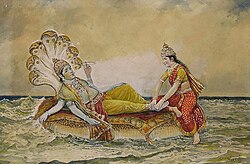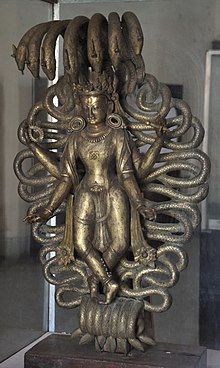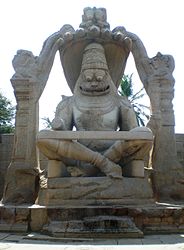
Shesha

| Shesha | |
|---|---|
King of the Serpents[1] | |
 Idol of Shesha, Kathmandu | |
| Other names | Sheshanaga, Ananta, Adishesha, Sankarshana |
| Affiliation | Vaishnavism |
| Abode | Vaikuntha, Kshira Sagara, Patala |
| Mantra | Om Nagkulaya Vidmahe Vishadantaya Dhimahi Tanno Sarpa Prachodayat |
| Genealogy | |
| Parents | |
| Siblings | Many including Manasa, Vasuki, and Takshaka |
| Consort | Nagalakshmi |
| Children | Sulochana |
| Part of a series on |
| Vaishnavism |
|---|
 |
Shesha (Sanskrit: शेष, romanized: Śeṣa, lit. 'Remainder'),[3] also known by his epithets Sheshanaga (Sanskrit: शेषनाग, romanized: Śeṣanāga, lit. 'The snake Shesha') and Adishesha (Sanskrit: आदिशेष, romanized: Ādiśeṣa, lit. 'First Shesha'), is a serpentine demigod (naga) and king of the serpents (Nagaraja), as well as a primordial being of creation in Hinduism. In the Puranas, Shesha is said to hold all the planets of the universe on his hoods and to constantly sing the glories of Vishnu from all his mouths. He is sometimes referred to as Ananta Shesha.

The Narayana form of Vishnu is often depicted as resting on Shesha, accompanied by his consort Lakshmi. Shesha is considered as one of the two mounts of Vishnu alongside Garuda. He is said to have descended upon Earth in the following human forms or incarnations: Lakshmana, brother of Vishnu's incarnation Rama during the Treta Yuga, and according to some traditions, as Balarama, brother of Vishnu's incarnation Krishna during the Dvapara Yuga. According to the Mahabharata (Adi Parva), his father was Kashyapa and his mother Kadru, though in other accounts, he is usually a primordial being created by Vishnu.

His name means "he who remains", from the Sanskrit root śiṣ, because even as the world is destroyed at the end of each kalpa, Shesha remains as he is.

Form

Shesha is generally depicted with a massive form that floats coiled through space, or upon the Ocean of Milk, to form the bed upon which Vishnu lies. Sometimes, he is depicted as a five-headed or seven-headed or a ten-headed serpent; but more commonly as one thousand-headed, or five thousand-headed, or even as many as a one million-headed serpent; sometimes with each head wearing an ornate crown.[4][5]

Origin and legends
According to the Mahabharata, Shesha was born to the sage Kashyapa and his wife Kadru. Kadru gave birth to a thousand snakes, of which Shesha was the eldest. After Shesha, Vasuki, Iravati and Takshaka were born, in that order. A lot of Shesha's brothers were cruel and were bent upon inflicting harm on others. They were even unkind to Garuda, who was Kashyapa's son through Vinata, sister of Kadru. (Kadru and Vinata were daughters of Daksha).

Shesha, disgusted by the cruel acts of his brothers, left his mother and kin, and took on austere penances. He lived on air and meditated in places including Gandhamadhana, Badrikashrama, Gokarna, Pushkara, and the Himalayas. His penances were so severe that his flesh, skin, and muscles dried up and merged with his frame. Brahma, convinced of Shesha's will, asked Shesha to request a boon. Shesha asked that he be able to keep his mind under control so that he could continue to perform ascetic penances. Brahma gladly accepted the request. Brahma then asked a favour of Shesha: to go beneath the precarious earth and stabilise it. Shesha agreed and went to the netherworld and stabilised Bhumi with his hood. He is believed to support her even today, thus making Patala his perennial residence.[6]

Vishnu and Shesha
Shesha is usually depicted as floating in the ocean of the changing world, forming the bed of a primordial form of Vishnu, i.e. Narayana, Vāsudeva or in later Puranic Vaishnavism, Mahavishnu.

In the Bhagavata Purana, Shesha is named Sankarshana, the tamasic energy of Narayana himself, and is said to live deep within the inner layers of Patala, where there are many serpents with gems on their heads and where he reigns as its ruler. He is said to have existed before the creation of the universe. When the universe is towards its end, he creates the 11 Rudras from the serpents to destroy the universe for a new one to be created.

Sankarshana is also one of the four vyuhas, or primitive forms of Vishnu, the other three being Vasudeva, Pradyumna, and Aniruddha.

In Gaudiya accounts, Sankarshana expands himself as Garbhodakshayi-Vishnu in the beginning of the universe to create Brahma. In other words, Sankarshana is believed to be Narayana himself.

In the first few chapters of the Puranas, it is also said that Sankarshana preached the Bhagavata to the Four Kumaras, who in turn passed on this message. At some point, the message was passed to sage Maitreya, who in turn preached it to Vidura.

Marriage
According to legends, Shesha is married to Nagalakshmi. As per the Garga Samhita, she is considered to be the personification of the divine ocean called the Kshira Sagara.[7][8]

Avatars
Shesha is believed to have taken six incarnations on earth. During the Satya Yuga, he came down in his original form to form a seat for Vishnu's avatar of Narasimha, who had incarnated to slay the impious Hiranyakashipu.

During the Treta Yuga, Shesha took birth as Lakshmana, as Vishnu's (as Rama) brother. Lakshmana is a very prominent character in the Ramayana, along with Hanuman and Sita. His consort, Nagalakshmi was born as Urmila, the sister of Sita.[9][10]

During Dvapara Yuga, he is a stated to have incarnated as Balarama again as a brother to Vishnu (as Krishna). This is often disputed by the original line-ups of the Dasavatara, where Balarama is also considered to be an incarnation of Vishnu. His consort was born as Revati, the daughter of King Kakudmi.[11][12]

During the Kali Yuga, according to Sri Vaishnava tradition, he was born as Patanjali, Ramanuja, and Manavala Mamunigal.[13] He was not accompanied by God during the Kali Yuga. Instead, he incarnated alone to spread devotion among the people, being a peaceful incarnation.

Sri Vaishnavism also states that Balarama is an incarnation of both Vishnu and Shesha. In the Bhagavad Gita, in the middle of the battlefield Kurukshetra, Krishna, explaining his omnipresence, says: "Of Nāgas, I am Ananta" indicating the importance of Shesha.

Gaudiya Vaishnavism states that Shesha incarnated as Nityananda, a friend and associate of Chaitanya Mahaprabhu, who is described as an incarnation of Krishna. According to the texts and scriptures of the Gaudiya Sampradaya, the appearance of Nityananda Prabhu was very similar to Balarama (incarnation of Shesha).[citation needed]

Literature
The Brahma Purana describes the attributes of Ananta:[14]

Daityas and Dānavas are not capable of recounting his good qualities. He is honoured by Devas and celestial sages. He is spoken of as Ananta. He has a thousand hoods, and he is clearly bedecked in Svastika ornaments devoid of impurities. He illuminates all quarters by thousand jewels on his hoods.
For the welfare of the universe, he deprives the Asuras of their prowess. His eyes whirl and rove due to intoxication. He has only one earring at all times.
Wearing a crown and garlands he shines like a white mountain aflame with fire.
He is clad in blue garments. He is intoxicated with pride. He is resplendent with white garlands. He is lofty like the mountain of Kailāsa where the celestial Gaṅgā falls. He has placed his hand on the plough-share; he holds an excellent iron club. He is attended upon by the embodied splendour of Varuṇa.
At the end of the Kalpa, Rudra in the form of Saṅkarṣaṇa comes out of his mouth, blazing like the flame of poisonous fire and devours the three worlds.
He holds the entire sphere of the world rising above like a peak.
— Brahma Purana, Chapter 19
The Brahmanda Purana also described Shesha in Patala:

With his two thousand eyes that have the reddish splendour of the rising sun and with his body that is white and glossy, he appears like the mountain. Kailāsa surrounded by clusters of flames. He has the white complexion like the Moon as well as the Kunda flowers. Hence the cluster of his eyes shines like the cluster of midday suns on the peak of the white Mountain (Śveta Parvata).
He has a huge terrible body. With it (resting) in his reclining pose on his couch, he appears like a thousand-peaked mountain of vast dimensions (resting) over the earth.
This (enormously) huge lord of serpents, himself of great splendour, is being attended upon by extremely wise and noble-souled great serpents of huge physique. He is the king of all serpents. He is Ananta, Śeṣa, of excessive brilliance.
— Brahmanda Purana, Chapter 20

The Bhagavata Purana equates Shesha and Balarama:

The foremost manifestation of Lord Vishnu is Sankarṣana, who is known as Ananta. He is the origin of all incarnations within this material world. Previous to the appearance of Lord Shri Krishna, this original Sankarsana will appear as Baladeva, just to please the Supreme Lord Shri Krishna in His transcendental pastimes."
— Bhagavata Purana, 10.1.24
In the Bhagavad Gita chapter 10, verse 29, Krishna describes 75 of his common manifestations, and declares, "anantaś ca asmi nāgānāṁ": Among Nāgas (a special class of serpents), I am the serpent-god Ananta.


-
Narasimha, the man-lion incarnation of Vishnu seated on the coils of Shesha, with seven heads of Shesha forming a canopy. Statue at Vijayanagara.
In popular culture
The Palliyodam, a type of large snake boat built and used by Aranmula Parthasarathy Temple in Kerala for the annual water processions of Uthrattathi Jalamela and Valla Sadhya has the legend that it was designed by Krishna and were made to look like Shesha.[15]

The capital of Kerala, Thiruvananthapuram, is named after the King of the Serpents and is translated as "The Sacred City of Ananta".

On the SCP Foundation wiki, the winning article for the SCP-3000 contest is titled Anantashesha. The article features SCP-3000, a gargantuan serpentine entity swimming in the Bay of Bengal with anomalous abilities, based on the fact that Shesha "would linger past the end".[16]

Other names
- Sheshanaga (Shesha the serpent)
- Shesha (the first Shesha)
- Anantashesha (Endless Shesha)
- Ananta (endless/infinite)
- Alternative spellings: Sesa, Shesha, Śeṣa
- Shesha Sayana or Nagar Syana means Vishnu who sleeps (Sayana) on Sheshanaga
See also
References
- ^ Handa 2004, p. 91.
- ^ Raj, Selva J.; Dempsey, Corinne G. (12 January 2010). Sacred Play: Ritual Levity and Humor in South Asian Religions. State University of New York Press. ISBN 978-1-4384-2981-6.
- ^ Haq, Kaiser (12 October 2015). The Triumph of the Snake Goddess. Harvard University Press. ISBN 978-0-674-91511-4. Archived from the original on 15 June 2023. Retrieved 29 July 2022.
- ^ Jones, Constance; Ryan, James D. (2006). Encyclopedia of Hinduism. Infobase Publishing. p. 288. ISBN 978-0-8160-7564-5.
- ^ Chenni Padmanabhan. Concept of Sri Andal's Tiruppavai. R.P. Publications, 1995 - Krishna (Hindu deity) in literature - 296 pages. p. 87.
- ^ Mbh, Adi Parva
- ^ Garga Saṁhita. Rasbihari Lal & Sons. 2006. ISBN 978-81-87812-98-2.
- ^ Śrīgargasaṃhitā: Kīrtibhāṣāsārasahitā (in Sanskrit). Vyāsa Bālābakṣa Śodhasaṃsthāna. 2000.
- ^ www.wisdomlib.org (24 June 2012). "Urmila, Urmilā, Ūrmilā: 9 definitions". www.wisdomlib.org. Retrieved 10 September 2022.
- ^ Agarwal, Shubhi (20 April 2022). LakshmiLa : The Eternal Love Story. Om Books International. ISBN 978-93-92834-21-9.
- ^ Revati. "Daughter of King Raivata and wife of Balarama."
- ^ Dalal, Roshen (18 April 2014). Hinduism: An Alphabetical Guide. Penguin UK. ISBN 978-81-8475-277-9.
- ^ "Manavala Mamunigal". acharya.org. Archived from the original on 27 March 2023. Retrieved 7 June 2022.
- ^ www.wisdomlib.org (17 March 2018). "The Magnitude of Netherworlds [Chapter 19]". www.wisdomlib.org. Archived from the original on 5 August 2022. Retrieved 13 August 2022.
- ^ "Explained: What is a Palliyodam, and why a Kerala actor was arrested for photoshoot on it". thenewsminute. Archived from the original on 13 September 2021. Retrieved 13 September 2021.
- ^ A Random Day; Ben "djkaktus" Sisson; Joreth (25 March 2017). "SCP-3000 - Anantashesha". SCP Foundation. Archived from the original on 12 May 2021. Retrieved 25 January 2022.
Bibliography
- Handa, Om Chanda (2004), Naga Cults and Traditions in the Western Himalaya, Indus Publishing, ISBN 978-8173871610
External links
See what we do next...
OR
By submitting your email or phone number, you're giving mschf permission to send you email and/or recurring marketing texts. Data rates may apply. Text stop to cancel, help for help.
Success: You're subscribed now !















